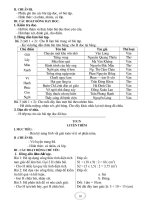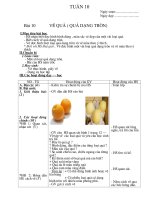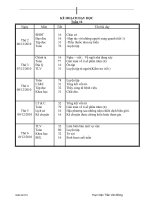Gián án Chapter 18 Electrochemistry
Bạn đang xem bản rút gọn của tài liệu. Xem và tải ngay bản đầy đủ của tài liệu tại đây (3.51 MB, 93 trang )
Chapter 18
Electrochemistry
2011, NKMB Co., Ltd.
Chemistry, Julia Burdge, 2
st
Ed.
McGraw Hill.
Mr. Truong Minh Chien ;
/>
2
Redox Reaction
•
one or more elements change oxidation number
all single displacement, and combustion,
some synthesis and decomposition
•
always have both oxidation and reduction
split reaction into oxidation half-reaction and a
reduction half-reaction
•
aka electron transfer reactions
half-reactions include electrons
•
oxidizing agent is reactant molecule that causes oxidation
contains element reduced
•
reducing agent is reactant molecule that causes reduction
contains the element oxidized
Chemistry, Julia Burdge, 2
nd
e., McGraw Hill.
3
Oxidation & Reduction
•
oxidation is the process that occurs when
oxidation number of an element increases
element loses electrons
compound adds oxygen
compound loses hydrogen
half-reaction has electrons as products
•
reduction is the process that occurs when
oxidation number of an element decreases
element gains electrons
compound loses oxygen
compound gains hydrogen
half-reactions have electrons as reactants
Chemistry, Julia Burdge, 2
nd
e., McGraw Hill.
4
Rules for Assigning Oxidation States
•
rules are in order of priority
1. free elements have an oxidation state = 0
Na = 0 and Cl
2
= 0 in 2 Na(s) + Cl
2
(g)
1. monatomic ions have an oxidation state equal
to their charge
Na = +1 and Cl = -1 in NaCl
1. (a) the sum of the oxidation states of all the
atoms in a compound is 0
Na = +1 and Cl = -1 in NaCl, (+1) + (-1) = 0
Chemistry, Julia Burdge, 2
nd
e., McGraw Hill.
5
Rules for Assigning Oxidation States
3. (b) the sum of the oxidation states of all the atoms in a
polyatomic ion equals the charge on the ion
N = +5 and O = -2 in NO
3
–
, (+5) + 3(-2) = -1
4. (a) Group I metals have an oxidation state of +1 in all
their compounds
Na = +1 in NaCl
4. (b) Group II metals have an oxidation state of +2 in all
their compounds
Mg = +2 in MgCl
2
Chemistry, Julia Burdge, 2
nd
e., McGraw Hill.
6
Rules for Assigning Oxidation States
5. in their compounds, nonmetals have oxidation
states according to the table below
nonmetals higher on the table take priority
Nonmetal Oxidation State Example
F -1 CF
4
H +1 CH
4
O -2 CO
2
Group 7A -1 CCl
4
Group 6A -2 CS
2
Group 5A -3 NH
3
Chemistry, Julia Burdge, 2
nd
e., McGraw Hill.
7
Oxidation and Reduction
•
oxidation occurs when an atom’s oxidation state
increases during a reaction
•
reduction occurs when an atom’s oxidation state
decreases during a reaction
CH
4
+ 2 O
2
→ CO
2
+ 2 H
2
O
-4 +1 0 +4 –2 +1 -2
oxidation
reduction
Chemistry, Julia Burdge, 2
nd
e., McGraw Hill.
8
Oxidation–Reduction
•
oxidation and reduction must occur simultaneously
if an atom loses electrons another atom must take them
•
the reactant that reduces an element in another reactant is
called the reducing agent
the reducing agent contains the element that is oxidized
•
the reactant that oxidizes an element in another reactant is
called the oxidizing agent
the oxidizing agent contains the element that is reduced
2 Na(s) + Cl
2
(g) → 2 Na
+
Cl
–
(s)
Na is oxidized, Cl is reduced
Na is the reducing agent, Cl
2
is the oxidizing agent
Chemistry, Julia Burdge, 2
nd
e., McGraw Hill.
9
Identify the Oxidizing and Reducing Agents
in Each of the Following
3 H
2
S + 2 NO
3
–
+ 2 H
+
→ 3 S + 2 NO + 4 H
2
O
MnO
2
+ 4 HBr → MnBr
2
+ Br
2
+ 2 H
2
O
Chemistry, Julia Burdge, 2
nd
e., McGraw Hill.
10
Identify the Oxidizing and Reducing Agents
in Each of the Following
3 H
2
S + 2 NO
3
–
+ 2 H
+
→ 3 S + 2 NO + 4 H
2
O
MnO
2
+ 4 HBr → MnBr
2
+ Br
2
+ 2 H
2
O
+1 -2 +5 -2 +1 0 +2 -2 +1 -2
ox agred ag
+4 -2 +1 -1 +2 -1 0 +1 -2
oxidation
reduction
oxidation
reduction
red agox ag
Chemistry, Julia Burdge, 2
nd
e., McGraw Hill.
11
Common Oxidizing Agents
Oxidizing Agent Product when Reduced
O
2
O
-2
H
2
O
2
H
2
O
F
2
, Cl
2
, Br
2
, I
2
F
-1
, Cl
-1
, Br
-1
, I
-1
ClO
3
-1
(BrO
3
-1
, IO
3
-1
) Cl
-1
, (Br
-1
, I
-1
)
H
2
SO
4
(conc) SO
2
or S or H
2
S
SO
3
-2
S
2
O
3
-2
, or S or H
2
S
HNO
3
(conc) or NO
3
-1
NO
2
, or NO, or N
2
O, or N
2
, or NH
3
MnO
4
-1
(base) MnO
2
MnO
4
-1
(acid) Mn
+2
CrO
4
-2
(base) Cr(OH)
3
Cr
2
O
7
-2
(acid) Cr
+3
12
Common Reducing Agents
Reducing Agent Product when Oxidized
H
2
H
+1
H
2
O
2
O
2
I
-1
I
2
NH
3
, N
2
H
4
N
2
S
-2
, H
2
S S
SO
3
-2
SO
4
-2
NO
2
-1
NO
3
-1
C (as coke or charcoal) CO or CO
2
Fe
+2
(acid) Fe
+3
Cr
+2
Cr
+3
Sn
+2
Sn
+4
metals metal ions
Tro, Chemistry: A Molecular Approach 13
Balancing Redox Reactions
1) assign oxidation numbers
a) determine element oxidized and element reduced
2) write ox. & red. half-reactions, including electrons
a) ox. electrons on right, red. electrons on left of arrow
3) balance half-reactions by mass
a) first balance elements other than H and O
b) add H
2
O where need O
c) add H
+1
where need H
d) neutralize H
+
with OH
-
in base
4) balance half-reactions by charge
a) balance charge by adjusting electrons
5) balance electrons between half-reactions
6) add half-reactions
7) check
Tro, Chemistry: A Molecular Approach 14
Ex 18.3 – Balance the equation:
I
−
(aq)
+ MnO
4
−
(aq)
→ I
2(aq)
+ MnO
2(s)
in basic solution
Assign
Oxidation
States
I
−
(aq)
+ MnO
4
−
(aq)
→ I
2(aq)
+ MnO
2(s)
Separate
into half-
reactions
ox:
red:
Assign
Oxidation
States
Separate
into half-
reactions
ox: I
−
(aq)
→ I
2(aq)
red: MnO
4
−
(aq)
→ MnO
2(s)
Tro, Chemistry: A Molecular Approach 15
Ex 18.3 – Balance the equation:
I
−
(aq)
+ MnO
4
−
(aq)
→ I
2(aq)
+ MnO
2(s)
in basic solution
Balance half-
reactions by
mass
ox: I
−
(aq)
→ I
2(aq)
red: MnO
4
−
(aq)
→ MnO
2(s)
Balance half-
reactions by
mass
ox: 2 I
−
(aq)
→ I
2(aq)
red: MnO
4
−
(aq)
→ MnO
2(s)
Balance half-
reactions by
mass
then O by
adding H
2
O
ox: 2 I
−
(aq)
→ I
2(aq)
red: MnO
4
−
(aq)
→ MnO
2(s)
+ 2 H
2
O
(l)
Balance
half-
reactions
by mass
then H by
adding H
+
ox: 2 I
−
(aq)
→ I
2(aq)
red: 4 H
+
(aq)
+ MnO
4
−
(aq)
→ MnO
2(s)
+ 2 H
2
O
(l)
Balance
half-
reactions
by mass
in base,
neutralize
the H
+
with OH
-
ox: 2 I
−
(aq)
→ I
2(aq)
red: 4 H
+
(aq)
+ MnO
4
−
(aq)
→ MnO
2(s)
+ 2 H
2
O
(l)
4 H
+
(aq)
+ 4 OH
−
(aq)
+ MnO
4
−
(aq)
→ MnO
2(s)
+ 2 H
2
O
(l)
+ 4 OH
−
(aq)
4 H
2
O
(aq)
+ MnO
4
−
(aq)
→ MnO
2(s)
+ 2 H
2
O
(l)
+ 4 OH
−
(aq)
MnO
4
−
(aq)
+ 2 H
2
O
(l)
→ MnO
2(s)
+ 4 OH
−
(aq)
Tro, Chemistry: A Molecular Approach 16
Ex 18.3 – Balance the equation:
I
−
(aq)
+ MnO
4
−
(aq)
→ I
2(aq)
+ MnO
2(s)
in basic solution
Balance
Half-
reactions
by charge
ox: 2 I
−
(aq)
→ I
2(aq)
+ 2 e
−
red: MnO
4
−
(aq)
+ 2 H
2
O
(l)
+ 3 e
−
→ MnO
2(s)
+ 4 OH
−
(aq)
Balance
electrons
between
half-
reactions
ox: 2 I
−
(aq)
→ I
2(aq)
+ 2 e
−
} x3
red: MnO
4
−
(aq)
+ 2 H
2
O
(l)
+ 3 e
−
→ MnO
2(s)
+ 4 OH
−
(aq)
}x2
ox: 6 I
−
(aq)
→ 3 I
2(aq)
+ 6 e
−
red: 2 MnO
4
−
(aq)
+ 4 H
2
O
(l)
+ 6 e
−
→ 2 MnO
2(s)
+ 8 OH
−
(aq)
Tro, Chemistry: A Molecular Approach 17
Ex 18.3 – Balance the equation:
I
−
(aq)
+ MnO
4
−
(aq)
→ I
2(aq)
+ MnO
2(s)
in basic solution
Add the
Half-
reactions
ox: 6 I
−
(aq)
→ 3 I
2(aq)
+ 6 e
−
red: 2 MnO
4
−
(aq)
+ 4 H
2
O
(l)
+ 6 e
−
→ 2 MnO
2(s)
+ 8 OH
−
(aq)
tot: 6 I
−
(aq)
+ 2 MnO
4
−
(aq)
+ 4 H
2
O
(l)
→ 3 I
2(aq)
+ 2 MnO
2(s)
+ 8 OH
−
(aq)
Check
Reactant
Count Element
Product
Count
6 I 6
2 Mn 2
12 O 12
8 H 8
2−
charge
2−
Tro, Chemistry: A Molecular Approach 20
Practice - Balance the Equation
ClO
3
-1
+ Cl
-1
→
Cl
2
(in acid)
Tro, Chemistry: A Molecular Approach 21
Practice - Balance the Equation
ClO
3
-1
+ Cl
-1
→
Cl
2
(in acid)
+5 -2 -1 0
oxidation
reduction
ox: 2 Cl
-1
→ Cl
2
+ 2 e
-1
} x5
red: 2 ClO
3
-1
+ 10 e
-1
+ 12 H
+
→ Cl
2
+ 6 H
2
O} x1
tot 10 Cl
-1
+ 2 ClO
3
-1
+ 12 H
+
→ 6 Cl
2
+ 6 H
2
O
1 ClO
3
-1
+ 5 Cl
-1
+ 6 H
+1
→
3 Cl
2
+ 3 H
2
O
Tro, Chemistry: A Molecular Approach 22
Electrical Current
•
when we talk about the current
of a liquid in a stream, we are
discussing the amount of water
that passes by in a given period
of time
•
when we discuss electric current,
we are discussing the amount of
electric charge that passes a
point in a given period of time
whether as electrons flowing
through a wire or ions flowing
through a solution
Tro, Chemistry: A Molecular Approach 23
Redox Reactions & Current
•
redox reactions involve the transfer of electrons
from one substance to another
•
therefore, redox reactions have the potential to
generate an electric current
•
in order to use that current, we need to separate
the place where oxidation is occurring from the
place that reduction is occurring
Tro, Chemistry: A Molecular Approach 24
Electric Current Flowing
Directly Between Atoms
Tro, Chemistry: A Molecular Approach 25
Electric Current Flowing
Indirectly Between Atoms
Tro, Chemistry: A Molecular Approach 26
Electrochemical Cells
•
electrochemistry is the study of redox reactions
that produce or require an electric current
•
the conversion between chemical energy and
electrical energy is carried out in an
electrochemical cell
•
spontaneous redox reactions take place in a
voltaic cell
aka galvanic cells
•
nonspontaneous redox reactions can be made to
occur in an electrolytic cell by the addition of
electrical energy
Tro, Chemistry: A Molecular Approach 27
Electrochemical Cells
•
oxidation and reduction reactions kept separate
half-cells
•
electron flow through a wire along with ion flow
through a solution constitutes an electric circuit
•
requires a conductive solid (metal or graphite)
electrode to allow the transfer of electrons
through external circuit
•
ion exchange between the two halves of the system
electrolyte









